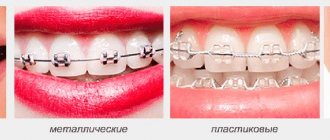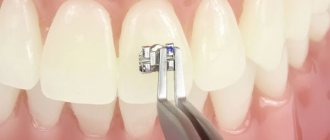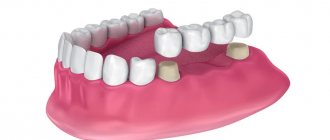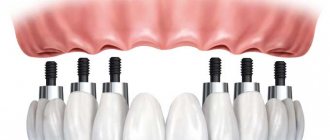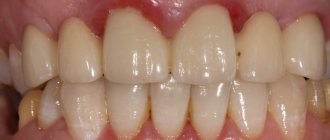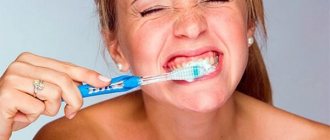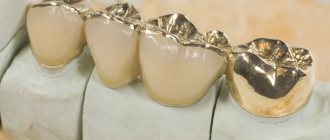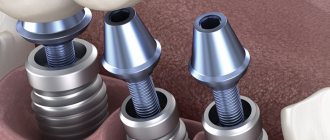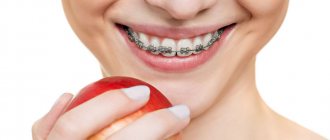Orthodontic treatment gives the best results in childhood. It is easier to correct malocclusion in children, since their jaw and teeth are just developing. However, this does not mean that braces are contraindicated for adults. They can be installed even after 30 years, but the treatment process will be longer. Let's consider its features.
The formation of the dental system ends around 17-18 years, but a child’s permanent bite is formed by 12-13 years. It is best, according to dentists, to install braces at the age of 10-12, when the last molars grow.
In this article
- Should I get braces after 30?
- In what cases should you get braces after 30 years?
- When should you not get braces at 30?
- Braces at 30: features of installation and wearing
- Which braces are best for people over 30?
- How to install braces for adults
- Does it hurt to wear braces?
However, it all depends on individual characteristics. Sometimes doctors suggest waiting a bit for the jaw to form without braces. And in some cases, on the contrary, their immediate installation is required. The need for such treatment is determined primarily by medical indications, and only then by the patient’s wishes.
Should I get braces after 30?
Many people believe that installing braces after 30 years is pointless, dangerous or painful, so they refuse orthodontic treatment. However, it is worth understanding that malocclusion, which can develop in various forms, can cause many complications. Among them:
- Caries, gingivitis and other oral diseases that occur due to poor hygiene and uneven distribution of chewing load.
- Pain in the jaw, which can radiate to the temples and eyebrows, which is a consequence of compression of the nerves and joints.
- Rapid wear of some teeth, abrasion of enamel, loss of teeth.
- Diseases of the gastrointestinal tract due to poor chewing of food.
- Psychological problems associated with self-esteem and complexes that an ugly smile gives rise to.
Let's consider the indications for which braces are placed even after 30 years.
In what cases should you get braces after 30 years?
The reason for installing braces at any age is an incorrect bite, which can manifest itself in different ways. Typical signs of this dental problem:
- crowding of teeth and their creeping onto each other;
- large interdental spaces;
- tooth growth to the sides;
- excessive protrusion of one jaw forward;
- large distance between the upper and lower rows of teeth;
- shifting the jaws sideways in opposite directions.
These anomalies are not always noticeable to the naked eye. In some people they are hidden, but at the same time they cause severe discomfort, for example, while eating. In this regard, many refuse to wear braces, getting used to this discomfort. However, it is recommended to undergo orthodontic treatment even in cases where there are malocclusions, but there is no visible aesthetic defect.
Personal experienceBraces in adulthood: Expectations and reality
I decided to get braces at the age of 22, in the spring of this year, after a preventive examination with a general dentist. Outwardly, my imperfections were almost not noticeable, the non-specialized doctor did not have strict recommendations, but I suddenly realized that I wanted (and could!) one day see perfectly straight teeth in the mirror. I thought for a few days and signed up for wisdom teeth removal - this is preparatory work before braces. Removal is the most unpleasant part, but the main thing is to get to the dentist-surgeon’s chair (I got a great one!) and endure the anesthetic injection. After the extraction, the doctor describes in detail what can go wrong, but everything can turn out even better than average: immediately after the removal of the first two teeth, I even went to a party - and the party was great.
In parallel with the extractions, I was looking for an orthodontist. Braces are a long-term treatment, so it is important not to make mistakes with your doctor. As a result, the method of “asking good doctors about other good doctors” helped: I chose an orthodontist on the recommendation of a dental surgeon. It’s funny that after frequent visits to dentists, my “third eye” opened, distinguishing between people with imperfect occlusion. Alas, perfectly straight teeth are almost always the result of correction. Acutely noticing the details around is a so-so superpower, the world has turned into a kind of perfectionist hell, but it seems that this period has passed.
I have noticeable metal braces on my teeth. Firstly, the doctor said that they are effective and unpretentious - transparent mouth guards, for example, need to be worn 22 hours a day, they should be removed while eating, that is, after dinner or lunch out of the house, you need to look for a washbasin and put your jaws in order so that put on a mouthguard. Secondly, truly invisible braces cost several hundred thousand rubles; such an investment in my situation does not seem reasonable.
I hardly feel any everyday inconveniences with braces. Teeth usually do not hurt, but it is better to avoid radishes and whole apples. Braces require careful care of the oral cavity with all sorts of devices, but this is generally useful for everyone, a good habit. I was a little worried about braces due to my profession, since sometimes I have important meetings at work. However, in vain: no one attaches any importance to this, and besides, braces hardly worsen diction (these are not children’s records); on the contrary, they can even improve it. I was pleased with the reaction of my loved ones. A loved one said that braces suit me very well (a dubious, but actually a very nice compliment). Friends praised him for his fortitude. Braces have truly added a healthy amount of self-confidence as a conscious and balanced life choice, and I'm so glad I went for it.
Rationally, braces mean straight teeth and health benefits at the cost of certain organizational efforts and time constraints. But when making a decision on an installation, many are confused by irrational things, reinforced by stereotypes in popular culture: “I’m not a teenager, it’s late, I’ll be like Katya Pushkareva, and everyone will point the finger at me, oh, wasted time...” The strangest thing is that I I heard from this episode: “I would like to get braces... but I can’t, I’m afraid that the lower jaw will change and become too masculine, ugly, oh, I should have done it earlier.” The truth is that you don't wake up a new person after getting braces. Passers-by do not hide their children when they see you on the street, flowers do not wither from your smile, a “crown of celibacy” does not suddenly grow on your head. There are reasonable difficulties in installing braces, it is a serious decision, but prejudices here will not help you make a choice.
Photos: nobeastsofierce - stock.adobe.com, goodween123 - stock.adobe.com, bergamont - stock.adobe.com
When should you not get braces at 30?
There are several more restrictions for installing braces at the age of 30 and later than contraindications for orthodontic treatment in childhood. This is due to the fact that the dental system has already been formed and some defects are difficult or even impossible to correct.
In addition, adults may have crowns or fillings in their mouths that interfere with the placement of orthodontic braces. There are other restrictions. In most cases they are relative:
- serious anatomical changes in the jaws;
- severe wear of crowns;
- the presence of carious cavities and old fillings;
- some diseases of the nervous and cardiovascular systems.
There are few absolute restrictions: HIV, tuberculosis, very weak immunity, etc. Before installing braces in adulthood, longer preparation is required. In general, the process of treating malocclusion in children and adults is practically no different. There are only a few nuances.
Optimal age category
According to orthodontists of the “Smile” dental clinic network, the optimal period for correcting occlusion using braces is from 13 to 18 years. Treatment after adulthood is also effective, but takes longer.
The effectiveness of therapy depends not only on the patient’s age, but also on other associated factors:
- the complexity of a particular clinical case;
- physiological characteristics;
- correctly selected correction system;
- a person’s discipline associated with maintaining oral hygiene and timely visits to the clinic to adjust the orthodontic device.
Braces at 30: features of installation and wearing
Getting braces at age 30 is not dangerous or painful, but orthodontic treatment in adulthood is not without difficulties. Often people encounter the following problems:
- Long preparation and treatment. Before installing orthodontic structures, all dental diseases must be cured. In adults there may be more of them than in children, so the preparatory stage of treatment can last for several weeks. Many people are interested in how long they need to wear braces if they are installed after 30 years. As practice shows, even minor defects require at least a year to eliminate; sometimes you have to wear braces for 2-3 years.
- It may be necessary to remove some teeth, often figure eights, to create space for the remaining teeth once they are straightened.
- In some cases, it is necessary, on the contrary, to install or replace additional structures, for example, crowns on which the braces will rest.
- It will take a long time to consolidate the result with the help of special means and instruments, otherwise the teeth may return to their original position. This often happens with significant defects.
In other words, an adult who wants to correct an overbite will have to be patient. The treatment will be long, but, according to people who have undergone it, it will be effective and justified.
Is it possible to straighten teeth without braces?
Any orthodontist knows well that parents who bring their heirs to an appointment always insist on installing braces, knowing full well how important the image role of a perfect smile is in our society. When it comes to straightening their own teeth, many try to limit themselves solely to masking existing anomalies with the help of ceramic veneers or lumineers. This is one of the significant features of adult patients.
But the laws of orthodontics do not depend on a person’s age. Therefore, neither an abnormal bite nor crowded teeth can be corrected by aesthetic dentistry. “Just straightening up your front teeth,” as an elegant lady aged 35+ wants, will not work if the reason for their protruding forward is a pathological bite. Whether you like it or not, you will have to wear braces.
Which braces are best for people over 30?
There are many varieties of brace systems, which differ from each other in a number of indicators: material of manufacture, strength, aesthetic properties, reliability of fixation, etc. As a rule, the orthodontist offers the patient several types of structures to choose from. When choosing braces, consider the following factors:
- Profession. A person who has to speak in public or often communicate with people can choose plastic, ceramic or sapphire braces: they are almost invisible to others. Lingual systems that are installed on the inner surface of the dentition are also well suited.
- The degree of bite pathology. Severe forms are better corrected with metal staples. In addition, they provide faster correction compared to plastic and ceramic structures.
- Price. The most expensive braces are made from sapphire, and ceramic products are also expensive. If you want to save money, but not at the expense of treatment, choose metal or plastic staples.
- Physical limitations. Lingual braces are more difficult to maintain. For people with disabilities, if they cannot fully care for their oral cavity, it is better to opt for vestibular structures.
But the main factor that determines the choice of braces is medical indications.
Price issue
The financial side of the course of treatment is directly related to the type of braces chosen. The total cost consists of such components as the material used to make the structure, the place and method of fastening, and the actions of the doctor.
In the proposed table, you can study the approximate price of each previously discussed system and find out the total cost of treatment, taking into account all preparatory procedures and control visits.
| Type of correction device | Cost, thousand rubles. | Total cost of treatment, thousand rubles. |
| Non-ligature braces | from 20 | up to 70 |
| Lingual system | from 45 | up to 110 |
| Ceramic braces | from 30 | up to 160 |
| Sapphire design | from 45 | up to 200 |
| Aligners (set of 10 pcs.) | from 25 | up to 150 |
All indicated figures may change upward or downward, based on the pricing policy of the clinic, its location and status, the qualifications of the doctor, etc.
In the video, a current dentist will complement the information presented above.
How to install braces for adults
Regardless of which system will be installed for the patient, he first undergoes an examination, during which indications and contraindications are determined. The main research method is radiography, which allows you to take pictures of the jaws and make impressions based on them. Next, the oral cavity is sanitized: treatment of dental diseases and ultrasonic cleaning. If necessary, extra teeth – molars or “eights” – are removed.
After preparation, the bracket system is installed. This is done according to the following algorithm:
- teeth are cleaned of plaque, saliva is removed, and the oral cavity is dried;
- the enamel is treated with a special solution, which makes it more susceptible to glue;
- An adhesive composition is applied to the surface of the tooth crown, and cement is applied to the bracket lock;
- the clasps are fixed on the teeth, after which they are dried with an ultraviolet lamp;
- excess glue is removed with a solvent;
- An arch is threaded into the braces, which corrects the bite by applying pressure to the jaw.
Installation can be direct or indirect. In the first case, each clasp is glued to one tooth; in the second, the dentist creates a structure on a mock-up of the jaw, and then transfers it to the patient’s oral cavity.
The arc has a memory effect and gradually begins to return to the shape that was given to it during the modeling of the structure. Due to this, tooth displacement occurs. Periodically, the arch is tightened to increase pressure on the dentition. This continues for 1-3 years, it all depends on the success of the treatment.
Problems with teeth and gums are a feature of adult orthodontic patients
Is it possible to put braces on crowns and filled teeth? This question is extremely relevant for adults who have decided to undergo orthodontic treatment, because the condition of their teeth, and sometimes gums, very often leaves much to be desired. The process is often complicated by the presence of a large number of fillings placed long ago, pulpless teeth covered with crowns, and sometimes problems with periodontium. Therefore, a patient who comes for an appointment at the orthodontic center for the first time is prescribed a thorough diagnosis, and based on its results, a consultation with specialized specialists: a therapist, a periodontist, a surgeon.
- Ultimately, only the doctor decides whether to put braces on fillings. It all depends on the condition of the tooth enamel, the quality and service life of the filling. If necessary, the tooth is resealed to prevent the “historic” dental cement from cracking or splitting.
- The problem with crowns is also solved individually. Teeth covered with them can only be moved if their roots are not damaged. If the crown is part of a bridge, the bridge will have to be sawed to release it, or it will have to be removed and a temporary plastic prosthesis made for the patient. Since the surface of the crowns is smoother than tooth enamel, it is best for the patient to install metal braces in installments, which have a more reliable fixation.
Does it hurt to wear braces?
Before installing orthodontic structures, people often wonder if it hurts to put on and wear braces. Painful sensations during the procedure occur only with increased sensitivity of the gums and teeth. To relieve the patient of discomfort, the doctor may give an anesthetic injection.
Pain during wearing braces usually only bothers you during the adaptation period, that is, in the first 5-15 days. If you do not eat hard foods, the pain will be mild. Pain medications are rarely needed.
For treatment to proceed without complications, the patient needs to change his diet and carefully monitor hygiene. You will have to limit yourself in the use of certain products and purchase special products for cleaning the oral cavity: a toothbrush with V-shaped bristles (CURAPROX Ortho), a brush (Biorepair Scovolini Interdentali Cilindrici), dental floss (Mirafloss implant chx), rinses (Biorepair Mouthwash) and irrigator (Little Doctor International Ltd Aquajet LD-A7, Donfeel Donfeel OR-820D Compact). You will need to see your doctor every few months to have the archwire tightened.
In general, it is safe to get braces after 30 years of age. However, they often have no alternative, so they will have to choose: either not try to solve the problems caused by malocclusion, or be patient a little and get a healthy and beautiful smile.
Pain and discomfort.
| Installing braces is absolutely painless, but the first days after installation and changing the arches, your teeth will ache. If braces rub the mucous membrane, you can seal them with special wax and use a gel with an anti-inflammatory effect. For example, Kamistad gel contains lidocaine as an anesthetic and chamomile extract to relieve inflammation and disinfect the injured surface. If you ignore damage to the mucosa, inflammation can lead to stomatitis and more serious consequences. |

